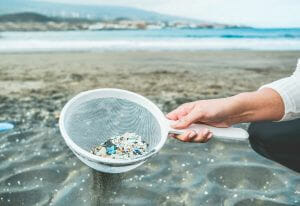“What are your sustainable options?” was the echo around the room at LuxePack last month.
As Mintel noted in its January 2019 report, “The current focus for zero-waste packaging solutions is on exploring new, post-consumer recycled (PCR) materials, and achieving a luxurious look while still being sustainable.” They add: “There is an opportunity for BPC brands to address the zero-waste packaging movement with creativity to differentiate from the competition.” But what are the opportunities, and what is the impact of current packaging solutions on both the environment and business? Here’s our deep dive into what we learned at the show:
1. Packaging Suppliers Are Innovating In Response To Demand
Eco-minded consumers are quick to know stats and facts about plastic: a plastic bottle takes 450 years to biodegrade; large plastics break down and become microplastics, which could add toxins to the oceans; mismanaged plastic contributes to even more waste entering oceans and landfills. From mass to prestige brands and everything in between, product developers in skin care and cosmetics are looking for different ways to approach green packaging. And while packaging suppliers are offering options that can be positioned as eco-friendly, the packaging experts we spoke with were quick to say there is no perfectly sustainable option right now — especially for smaller brands who require stock packaging and can’t afford custom development. For now, much of the “how” and “how much” is being put on brands.
2. Popular Options: Bioplastic & Sugar Cane
 The most common sustainable-positioned packaging option we saw for skin care tubes was a bioplastic made from sugar cane. The carbon footprint of a sugarcane tube is less than that of a conventional PE (polyethylene) tube, which is a major win for eco-minded brands and their consumers. But there are certain drawbacks. For one, it isn’t biodegradable, so after use, the tube will likely meet a similar fate as the plastic it’s intended to replace. We get it, many consumers are crying out for anything but plastic, but as Beauty Packaging has noted in the past, sugar cane bioplastic “reduces fossil fuel usage, but can negatively impact food and water security and is functionally still a plastic.” Plus, though the tube itself may be recyclable, oftentimes the other components —like the cap and pump — are not. Since consumer awareness on what can and cannot be recycled is pretty low, brands need to do a major education overhaul to make sure their green packaging choice has an impact, and to take their sustainability promise beyond a marketing tactic.
The most common sustainable-positioned packaging option we saw for skin care tubes was a bioplastic made from sugar cane. The carbon footprint of a sugarcane tube is less than that of a conventional PE (polyethylene) tube, which is a major win for eco-minded brands and their consumers. But there are certain drawbacks. For one, it isn’t biodegradable, so after use, the tube will likely meet a similar fate as the plastic it’s intended to replace. We get it, many consumers are crying out for anything but plastic, but as Beauty Packaging has noted in the past, sugar cane bioplastic “reduces fossil fuel usage, but can negatively impact food and water security and is functionally still a plastic.” Plus, though the tube itself may be recyclable, oftentimes the other components —like the cap and pump — are not. Since consumer awareness on what can and cannot be recycled is pretty low, brands need to do a major education overhaul to make sure their green packaging choice has an impact, and to take their sustainability promise beyond a marketing tactic.
3. Recycled Ingredients & Ocean Plastics

Another thing we saw a lot of was the use of PCR materials — specifically ocean plastics. This hits home with the increasing number of consumers who are concerned about ocean plastics and has the added benefit of reducing the production of new plastics. We saw recycled plastics used in bags as well as product packaging like tubes, and some vendors offered both tubes and caps made from recycled materials. The downfall: these are typically discarded in the same way as standard PE (polyethylene) tubes.
4. The Lowdown On Recyclable Packaging
Some mono-layer (i.e., single layer) plastic packaging is recyclable, because it doesn’t have adhesive and decorative layers that are on most beauty products. But mono-layer packaging isn’t ideal for all types of products or for all brands. Recycling guidelines differ by location, and since many products cannot be recycled in their entirety, brands need to work to restore consumer faith in a cosmetics recycling program. An example of this is the Terracycle program, which had 27,575 participating locations and 12,212,416 units of waste recycled at the time this blog post was written on May 22, 2019.
5. Reusable via Refillable Packaging

brands (and suppliers) in the premium space are taking a more nuanced view of sustainability and seeking out products that will effectively make consumers waste less. Some of these products are refillable, while others are elegant and design-driven so consumers will want to repurpose them. In the cosmetics space, we saw this in the lip and eye categories, which readily lend themselves to a refillable product concept, and to having both a single-use inner component and a refillable outer pack.
Looking Towards A Sustainable Future
Mintel’s report, “Imaginative solutions for zero-waste packaging” notes that “[i]n the quest for plastic alternatives, new ideas are emerging in the field of biomaterials that present new possibilities for future beauty packaging.” We have a long way to go as an industry, but the more that brands, consumers, and contract manufacturers ask for sustainable solutions, we’re sure to see zero-waste options in the future. In the meantime, brands have to do their own research and decide where their priorities lie — and remember to ask the tough questions along the way.
You must be logged in to post a comment.